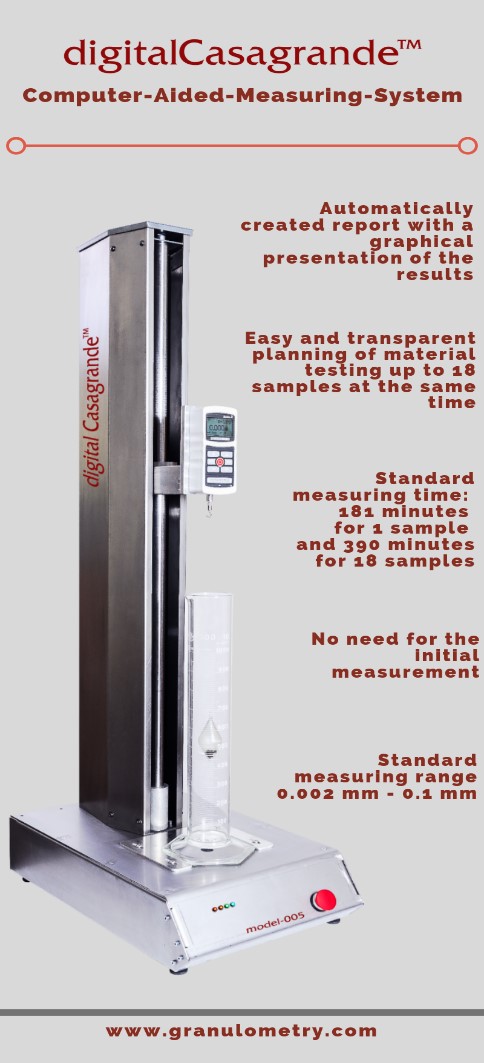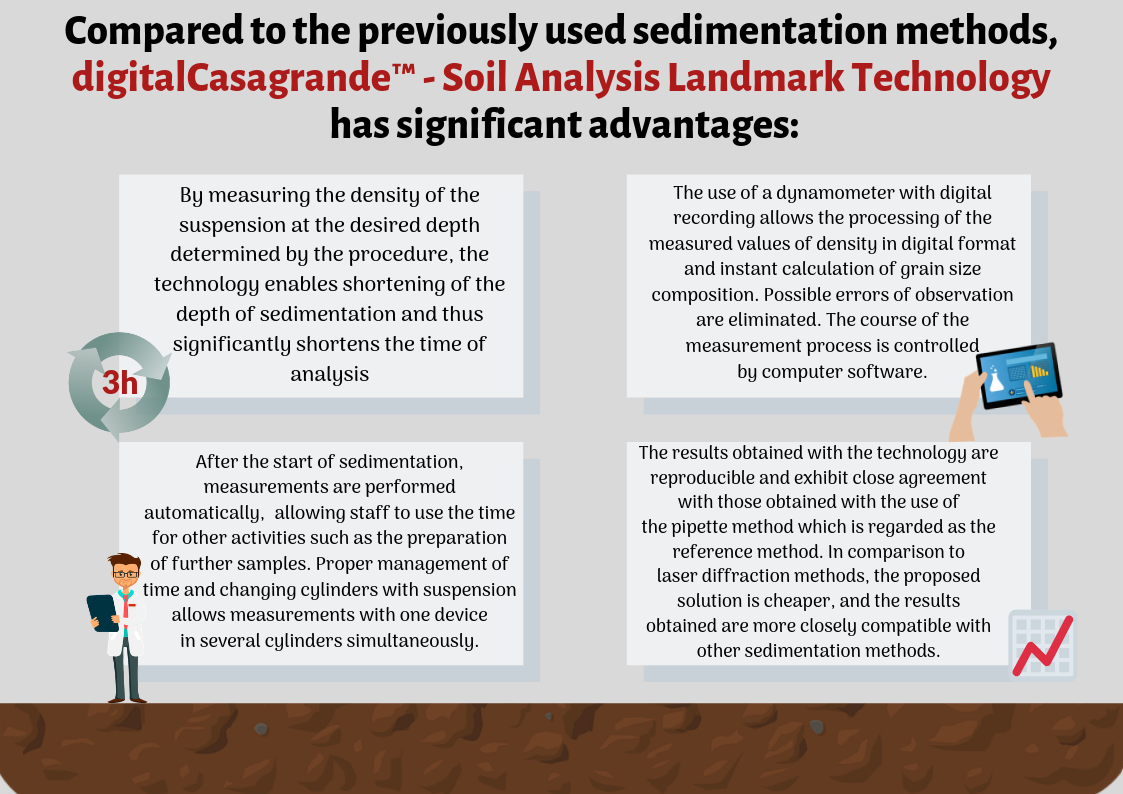- Szczegóły
- Kategoria: Rachunkowość
![]() is distinguished by the readiness to revolutionize both the world of science (soil science, soil physics, etc.) as well as the market of soil-science laboratories.
is distinguished by the readiness to revolutionize both the world of science (soil science, soil physics, etc.) as well as the market of soil-science laboratories.
![]() uses the phenomenon of sedimentation. The devices allow determining the grain-size-distribution of the ground material below 0.1 mm, based on the result of the measurement of the apparent weight of the float suspended in the suspension. The time of determination of the grain-size-distribution of the test sample is less than three hours, in the grain diameter range of 0.1 - 0.002 mm. In addition, the devices allow measuring the total content of fractions smaller than 0.001 mm, any choice of dimensions and the number of fractions measured.
uses the phenomenon of sedimentation. The devices allow determining the grain-size-distribution of the ground material below 0.1 mm, based on the result of the measurement of the apparent weight of the float suspended in the suspension. The time of determination of the grain-size-distribution of the test sample is less than three hours, in the grain diameter range of 0.1 - 0.002 mm. In addition, the devices allow measuring the total content of fractions smaller than 0.001 mm, any choice of dimensions and the number of fractions measured.
![]() was subjected to expert analysis for validation in the laboratories of our partners from the International Soil Research & Technology Cluster. The results of the tests turned out to be highly satisfactory and yielded a clearly positive conclusion.
was subjected to expert analysis for validation in the laboratories of our partners from the International Soil Research & Technology Cluster. The results of the tests turned out to be highly satisfactory and yielded a clearly positive conclusion.
![]() is unique in the global market. Unlike other companies producing measuring devices, we are the only one which is working on our own, patented, dynamometric method of grain-size distribution analysis.
is unique in the global market. Unlike other companies producing measuring devices, we are the only one which is working on our own, patented, dynamometric method of grain-size distribution analysis.

- Szczegóły
- Kategoria: Rachunkowość
Artykuły:
- Oznaczanie składu granulometrycznego metodą dynamometryczną – porównanie z metodą pipetową i areometryczną
- Grain size analysis by dynamometric method – comparison with the pipette and hydrometer method
- Determination of soil grain size composition by measuring apparent weight of float submerged in suspension

Fully automated, computer-controlled measurement using specialized software.
Digital transmission of results from the dynamometer, temperature sensor and distance measuring device defining the depth of immersion of the float to the computer facilitates automatic calculations of granulometric composition, with the elimination of an observer.
MEASURMENT IN LINE WITH THE NORMS:
1) Die Internationale Norm ISO 11277:198-05-15 “Soil quality, Determination of particle size distribution in mineral soil material – Method by sieving and sedimentation”, sowie die Internationale Anderung 1:2002-03-01 zu ISO 11277:1988 sind unveraderet in diese Deutsche Norm ubernommen worden.
2) BS 1377-2:1990. Methods of test for Soils for civil engineering purposes —Amendment No. 1
3) ASTM Committee D-18 on Soil and Rock and is the direct responsibility of Subcommittee D18.03 on Texture, Plasticity, and Density Characteristics of Soils.
APPROACH - THE TECHNOLOGY
The new technology for determining the particle size composition of soils is based on the our own, patented dynamometric method of grain-size distribution analysis using the phenomenon of sedimentation, combines the accuracy of results obtained using the pipette method with the possibility of measuring any number of selected size fractions and a shortened measurement time in comparison to the SHM and PM methods.
The technology allows determining the grain-size-distribution of the ground material below 0.1 mm, based on the result of the measurement of the apparent weight of the float suspended in the suspension. The time of determination of the grain-size-distribution of the test sample is less than three hours, in the grain diameter range of 0.1 - 0.002 mm. In addition, the device allows measuring the total content of fractions smaller than 0.001 mm, any choice of dimensions and the number of fractions measured.
The density of suspension is determined on the basis of apparent weight changes of a float submerged in it. The weight of the float suspended on a thin line, at a given depth in the suspension, is measured with a sensitive piezoelectric dynamometer. The Stokes equation is used to calculate the content of soil fractions with equivalent diameters in the range of 0.001 to 0.1 mm.
Digital transmission of results from the dynamometer, the temperature sensor and measurements of the distance defining the depth of immersion of the float to the computer enables calculations of particle size composition to be performed automatically. A high level of repeatability of the results and satisfactory compatibility in relation to the reference pipette method are noted.

The Cartesian-Gantry-System project is implemented in cooperation with our partners from the International Soil Research & Technology Cluster.
The critical concepts of technology have been confirmed analytically and experimentally. Scientific research and analytical tests were carried out to confirm the keys elements of technology, integrated components, efficiency, etc.
- Increase of laboratory efficiency - 14 samples analysis in 3 hours
- Improvement of analysis quality
- Increase of results’ quality
- Easy to use - preparation of samples analogous to the hydrometric method
- The calculation algorithm is simple and anyone can verify it
- Accessibility for people with disabilities
- Environmentally friendly


